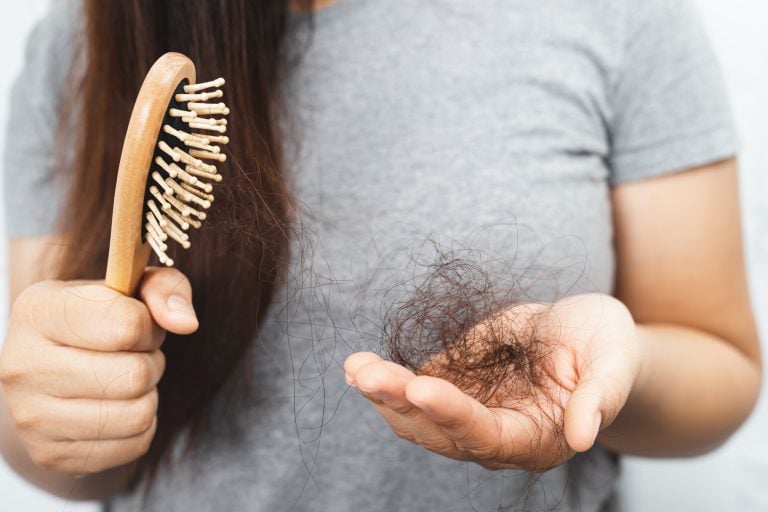Cervical dysplasia refers to pre-cancerous changes in the cells on the surface of the cervix. Although several factors contribute to dysplasia, one common issue is human papillomavirus, or HPV. Approximately 40 percent of American women (and 45 percent of men)1Hung M, Su S, Hon ES, et al. Health disparities associated with females reporting human papillomavirus infection in the United States. Women’s Health Rep (New Rochelle). 2021 Jul 14;2(1):245-253. https://doi.org/10.1089/whr.2021.0036,2Han JJ, Beltran TH, Song JW, Klaric J, Choi YS. Prevalence of genital human papillomavirus infection and human papillomavirus vaccination rates among US adult men: National Health and Nutrition Examination Survey (NHANES) 2013-2014. JAMA Oncol. 2017 Jun 1;3(6):810-816. https://doi.org/10.1001/jamaoncol.2016.6192 have one type of HPV. The body will often resolve an HPV infection on its own, with cervical cells returning to normal. However, in some cases, cervical dysplasia may worsen. Without treatment, advanced cervical dysplasia can progress to cervical cancer. Over the past 40 years, pap smears and early detection have lowered the incidence of cervical cancer by half in the United States.3Practice Bulletin No. 168: Cervical Cancer Screening and Prevention. Obstet Gynecol. 2016 Oct;128(4):e111-e130. https://doi.org/10.1097/AOG.0000000000001708
Naturopathic doctors who specialize in women’s health offer you and your sexual partner both preventive education and natural treatments for dysplasia and HPV. Naturopathic doctors focus on the least invasive, most natural, effective treatments first, and partner with conventionally trained specialists if surgical interventions are needed.
Risk factors
The main risk factor for cervical dysplasia is the presence of HPV. Other determinants include the following:
- Multiple sexual partners
- Age at first intercourse (under 16)
- Intercourse with an uncircumcised partner
- Unprotected sex
- Chlamydia and HIV
- Compromised immune system
- Smoking
- Nutritional deficiencies
- Diethylstilbestrol (DES) exposure
- Long-term oral contraceptive use (more than 5 years)
- Socioeconomic status
Screenings and prevention
Naturopathic doctors follow guidelines from the American College of Obstetricians and Gynecologists for dysplasia and HPV screening. Pap smear and HPV tests are standard protocols for women 21 to 65. Additionally, NDs recommend and perform screenings for HPV and dysplasia in the mouth, throat, and anus, where the virus can also be spread through contact with sexual partners.4J Oral Pathol Med. 2015 Jan; 44(1): 28-36. Patients with abnormal results or a positive HPV test are encouraged to inform their sexual partners, who may also consider testing and treatment to help prevent further transmission.
Naturopathic doctors emphasize preventive measures:
- Practicing safe sex. Safe sex decreases transmission of HPV, HIV, and other sexually transmitted diseases.
- Smoking cessation. Smoking is linked to cervical cancer as it increases the duration of infection with high-risk HPV.5Tolstrup J, Munk C, Thomsen B, et al. The role of smoking and alcohol intake in the development of high-grade squamous intraepithelial lesions among high-risk HPV-positive women. National Center for Biotechnology Information. 2006. https://www.ncbi.nlm.nih.gov/pubmed/16929418. Accessed April 15, 2015. Smoking also weakens the immune system.
- Optimizing nutrition. Folate and B12 deficiencies have been associated with increased HPV infection.6Weinstein SJ, et al. Low serum and red blood cell folate are moderately but nonsignificantly associated with an increased risk of invasive cervical cancer. J Nutr. 2001;131:2040-2048.p Low serum retinol levels have been linked to an increased risk of dysplasia.7Schiff MA, et al. Serum carotenoids and risk of cervical epithelial neoplasia in southwestern American women. Cancer Epidemiol Biomarkers Prev. 2001;10:1219-1222 NDs provide a comprehensive nutritional intake and dietary counseling to address any deficiencies.
HPV vaccination can reduce the risk of certain HPV strains. Because no currently available HPV vaccine protects against all viruses, vaccinated women need to continue to undergo cervical cancer screening.
Diagnosis
Following a cervical dysplasia or HPV diagnosis, an ND may order a colposcopy to determine the extent and degree of dysplasia. Dysplasia is then categorized as cervical intraepithelial neoplasia and graded either level I (lower-grade change in cervical cells), II, or III (highest-grade change).
Treatment
Conventional treatment typically entails one or more of four treatment approaches for dysplasia:
- “Watch and wait,” repeating pap smear testing every 3 to 6 months
- Cryotherapy to freeze abnormal cells
- Loop electrosurgical excision procedure (LEEP), which uses electricity to remove affected tissue
- Cone biopsy, to remove the affected portion of the cervix
Surgical risks and complications include scar tissue, prolonged bleeding, and infection and may have longer-term effects on conception and childbirth.8Int J Gynaecol Obstet. 2016 Mar;132(3):266-71. https://doi.org/10.1016/j.ijgo.2015.07.026 Additionally, these treatments might not address HPV infection, the underlying cause of cervical dysplasia.
Naturopathic doctors provide natural therapies aimed at supporting the body’s immune system to combat HPV and dysplasia. These approaches may help reverse low-grade cervical cell abnormalities and eliminate the virus. Treatment for low- and mid-grade dysplasia typically involves a combination of lifestyle modifications, therapeutic diets, nutrient and botanical therapies, and localized cervical treatments. Therapies are tailored to each patient based on their diagnosis, as well as their individual physical and emotional constitution. Nutrient and botanical therapies may include the following:
- Folic acid9Marshall K. Cervical dysplasia: early intervention. Altern Med Rev. 2003;8(2):156-70.
- Indole-3-carbinol10Grubbs CJ, Steele VE, Casebolt T, et al. Chemoprevention of chemically-induced mammary carcinogenesis by indole-3-carbinol. Anticancer Res 1995;15:709-716.,11Bell MC, Crowley-Nowick P, Bradlow HL, et al. Placebo-controlled trial of indole-3-carbinol in the treatment of CIN. Gynecol Oncol 2000;78:123-129.
- Antioxidants12Palan PR, Mikhail MS, Basu J, Romney SL. Plasma levels of antioxidant beta-carotene and alpha-tocopherol in uterine cervix dysplasia and cancer. Nutr Cancer. 1991;15:13-20.,13Mikhail MS, Palan PR, Romney SL. Coenzyme Q0 and alpha-tocopherol concentrations in cervical intraepithelial neoplasia and cervix cancer. Obstet Gynecol. 2001;97:3S.
- Vitamin C14Ghosh C, et al. Dietary intakes of selected nutrients and food groups and risk of cervical cancer. Nutr Cancer. 2008;60(3):331-41.,15Lee Gj, et al. Antioxidant vitamins and lipid peroxidation in patients with cervical intraepithelial neoplasia. J Korean Med Sci. 2005 Apr;20(2):267-72.
- Green tea extract16Ahn WS, et al. The protective effects of green tea extract on human cervical lesions. Eur J Cancer Prev 2003;12(5):383-390.
- Coriolus versicolor17Bogdanova J. [Coriolus versicolor–innovation in prevention of oncogynecological diseases, especially HPV]. Akush Ginekol (Sofiia). 2008;47 Suppl 3:51-3.
- Curcumin18Mishra A., Kumar R., Kohaar, Curcumin Modulates Cellular AP-1, NF-kB, and HPV16 E6 Proteins in Oral Cancer. Ecancermedicalsciene 9, 525 (2015).
- Methyl B1219Piyathilake CJ, Cancer Prev Res (Phila). 2014 Nov; 7(100): 1128-1137.
Local cervical treatments
- Vaginal suppositories consisting of green tea and/or curcumin, which draw infection out of the cervical cells and boost the immune system.20Int J Gynecol Cancer. 2010; 20(4): 617-624,21Gattoc L. et al, Open Access J Clin Trials. 2017;9:1-10. https://doi.org/10.2147/OAJCT.S105010
- Escharotic treatment uses natural enzymes and herbal solutions to remove abnormal, damaged tissue and stimulate the regrowth of normal tissue. This treatment is performed two times per week for approximately six weeks.22Windstar, K., Dunlap, C., Zwickey H. Escharotic Treatment for ECC-positive CIN3 in Childbearing Years: A Case Report. Integr Med (Encinitas). 2014 Apr;13(2):43-9.,23Swanick, S., Windstar-Hamlin K., Zwickey H., An alternative treatment for cervical intraepithelial neoplasia II, III. Integr Cancer Ther. 2009 Jun;8(2):164-7. https://doi.org/10.1177/1534735409335504
Thousands of patients have safely benefited from these treatments; however, larger clinical studies are still needed. A comprehensive diagnosis and consideration of all available options are essential for effective cervical health management. In many cases, naturopathic approaches to managing cervical dysplasia and HPV can be a safe and effective option.
Special thanks to Marianne Marchese, ND, for contributing to this article.
Footnotes
- 1Hung M, Su S, Hon ES, et al. Health disparities associated with females reporting human papillomavirus infection in the United States. Women’s Health Rep (New Rochelle). 2021 Jul 14;2(1):245-253. https://doi.org/10.1089/whr.2021.0036
- 2Han JJ, Beltran TH, Song JW, Klaric J, Choi YS. Prevalence of genital human papillomavirus infection and human papillomavirus vaccination rates among US adult men: National Health and Nutrition Examination Survey (NHANES) 2013-2014. JAMA Oncol. 2017 Jun 1;3(6):810-816. https://doi.org/10.1001/jamaoncol.2016.6192
- 3Practice Bulletin No. 168: Cervical Cancer Screening and Prevention. Obstet Gynecol. 2016 Oct;128(4):e111-e130. https://doi.org/10.1097/AOG.0000000000001708
- 4J Oral Pathol Med. 2015 Jan; 44(1): 28-36.
- 5Tolstrup J, Munk C, Thomsen B, et al. The role of smoking and alcohol intake in the development of high-grade squamous intraepithelial lesions among high-risk HPV-positive women. National Center for Biotechnology Information. 2006. https://www.ncbi.nlm.nih.gov/pubmed/16929418. Accessed April 15, 2015.
- 6Weinstein SJ, et al. Low serum and red blood cell folate are moderately but nonsignificantly associated with an increased risk of invasive cervical cancer. J Nutr. 2001;131:2040-2048.p
- 7Schiff MA, et al. Serum carotenoids and risk of cervical epithelial neoplasia in southwestern American women. Cancer Epidemiol Biomarkers Prev. 2001;10:1219-1222
- 8Int J Gynaecol Obstet. 2016 Mar;132(3):266-71. https://doi.org/10.1016/j.ijgo.2015.07.026
- 9Marshall K. Cervical dysplasia: early intervention. Altern Med Rev. 2003;8(2):156-70.
- 10Grubbs CJ, Steele VE, Casebolt T, et al. Chemoprevention of chemically-induced mammary carcinogenesis by indole-3-carbinol. Anticancer Res 1995;15:709-716.
- 11Bell MC, Crowley-Nowick P, Bradlow HL, et al. Placebo-controlled trial of indole-3-carbinol in the treatment of CIN. Gynecol Oncol 2000;78:123-129.
- 12Palan PR, Mikhail MS, Basu J, Romney SL. Plasma levels of antioxidant beta-carotene and alpha-tocopherol in uterine cervix dysplasia and cancer. Nutr Cancer. 1991;15:13-20.
- 13Mikhail MS, Palan PR, Romney SL. Coenzyme Q0 and alpha-tocopherol concentrations in cervical intraepithelial neoplasia and cervix cancer. Obstet Gynecol. 2001;97:3S.
- 14Ghosh C, et al. Dietary intakes of selected nutrients and food groups and risk of cervical cancer. Nutr Cancer. 2008;60(3):331-41.
- 15Lee Gj, et al. Antioxidant vitamins and lipid peroxidation in patients with cervical intraepithelial neoplasia. J Korean Med Sci. 2005 Apr;20(2):267-72.
- 16Ahn WS, et al. The protective effects of green tea extract on human cervical lesions. Eur J Cancer Prev 2003;12(5):383-390.
- 17Bogdanova J. [Coriolus versicolor–innovation in prevention of oncogynecological diseases, especially HPV]. Akush Ginekol (Sofiia). 2008;47 Suppl 3:51-3.
- 18Mishra A., Kumar R., Kohaar, Curcumin Modulates Cellular AP-1, NF-kB, and HPV16 E6 Proteins in Oral Cancer. Ecancermedicalsciene 9, 525 (2015).
- 19Piyathilake CJ, Cancer Prev Res (Phila). 2014 Nov; 7(100): 1128-1137.
- 20Int J Gynecol Cancer. 2010; 20(4): 617-624
- 21Gattoc L. et al, Open Access J Clin Trials. 2017;9:1-10. https://doi.org/10.2147/OAJCT.S105010
- 22Windstar, K., Dunlap, C., Zwickey H. Escharotic Treatment for ECC-positive CIN3 in Childbearing Years: A Case Report. Integr Med (Encinitas). 2014 Apr;13(2):43-9.
- 23Swanick, S., Windstar-Hamlin K., Zwickey H., An alternative treatment for cervical intraepithelial neoplasia II, III. Integr Cancer Ther. 2009 Jun;8(2):164-7. https://doi.org/10.1177/1534735409335504





